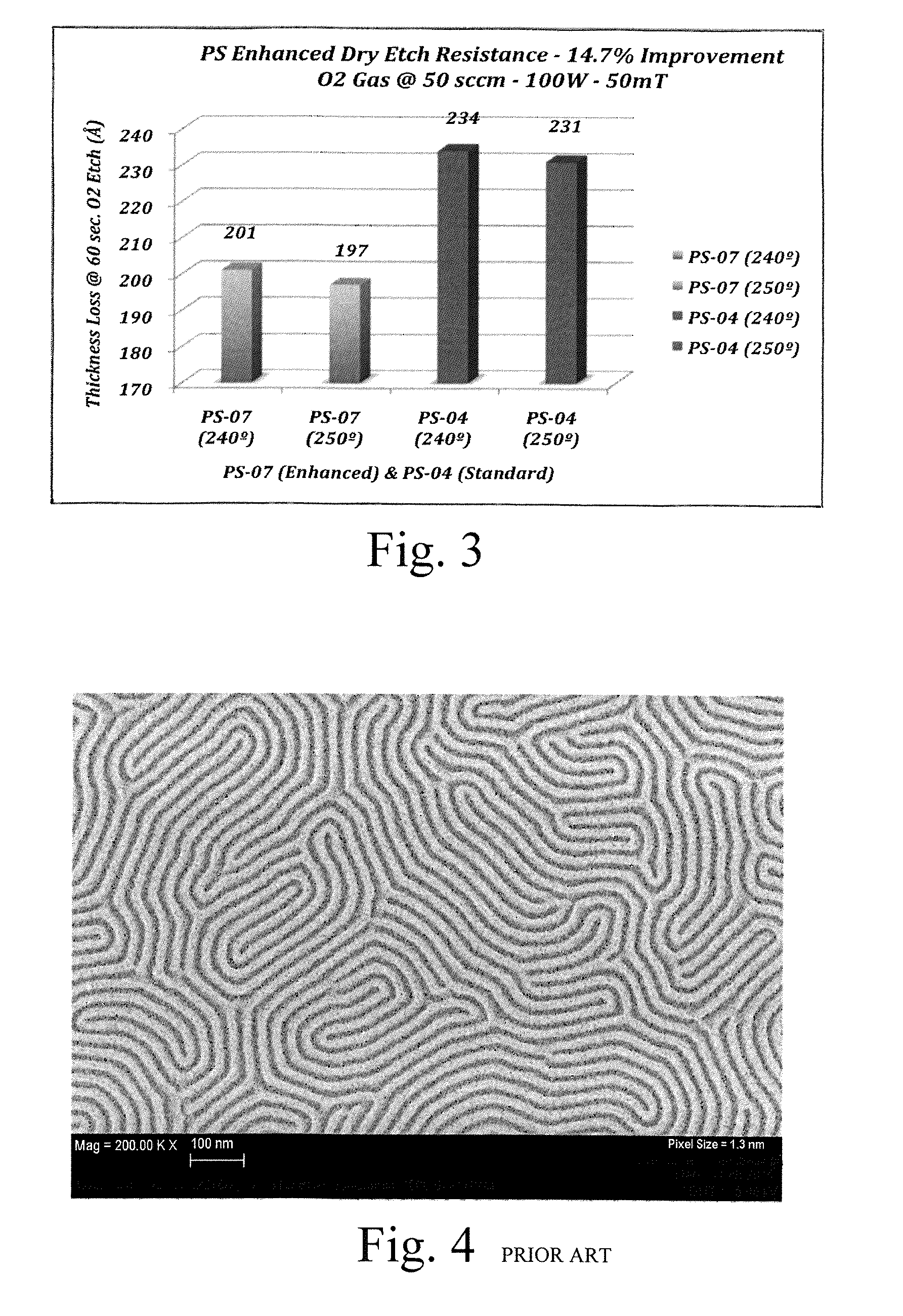Highly etch-resistant polymer block for use in block copolymers for directed self-assembly
a polymer block and high-etch-resistant technology, applied in the field of new block copolymers and directed self-assembly compositions, can solve the problems of significant thickness loss of ps, insufficient real resolution limit of single patterning 193 nm immersion scanners, etc., and achieve the effect of facilitating alignment and surface energy
- Summary
- Abstract
- Description
- Claims
- Application Information
AI Technical Summary
Benefits of technology
Problems solved by technology
Method used
Image
Examples
example 1
Synthesis of Poly(styrene-co-4-vinylbenzocyclobutene)
[0071]
Synthesis of Poly(styrene-co-4-vinylbenzocyclobutene) (P(S-VBCB))
[0072]A solution of 3.4 grams of styrene (Sigma-Aldrich, St. Louis, Mo.), 3.5 grams of 4-vinylbenzocyclobutene (VBCB) (Sigma-Aldrich, St. Louis, Mo.), and 4.1 milligrams of 2,2′-azobis(2-methylpropionitrile) (AIBN) (Sigma-Aldrich, St. Louis, Mo.) in 2 mL of toluene (Sigma-Aldrich, St. Louis, Mo.) was prepared in a 50-milliliter flask and stirred at room temperature for 15 minutes under nitrogen atmosphere. The solution was then transferred into a 50-milliliter Schlenk reaction flask containing 27.2 miligrams of 2-cyano-2-propyl dodecyl trithiocarbonate (Sigma-Aldrich, St. Louis, Mo.). The reaction mixture in the Schlenk reaction flask was then de-gassed by three repeated freeze-evacuate-thaw cycles and sealed in vacuum. The Schlenk reaction flask was put in a heated oil bath (96° C.) for 17 hours. The viscous reaction mixture obtained was diluted with 20 mL of ...
example 2
Crosslinking and Etch Rate Validation of Poly(styrene-co-4-vinylbenzocyclobutene)
[0073]The poly(styrene-co-4-vinylbenzocyclobutene) (P(S-VBCB)) random copolymer from Example 1 was tested to validate that the modifications to the chemical structure of the PS block were able to be crosslinked successfully using heat. Six 150-mm silicon wafers were coated with the P(S-VBCB) using a spin speed of 1,500 rpm for 60 seconds and baked on a hot plate with temperatures varying from 200° C. to 250° C. in increments of 10° C., yielding a film thickness of about 250 Å. Initial thickness measurements were taken using a J.A. Woollam M2000 VUV-VASE tool. Wafers then were subjected to a static dispense of PGMEA (Ultra Pure Solutions, Inc., Castroville, Calif.) for 1 minute and then remeasured to analyze the amount of thickness loss. If the material was fully crosslinked, there would be minimal thickness loss. The results shown in Table 1 indicate that successful thermal crosslinking occurs at 240-25...
example 3
Synthesis of Poly(styrene-co-4-vinylbenzocyclobutene)-b-poly(methyl methacrylate) Block Copolymers
[0075]
Synthesis of Poly(styrene-co-4-vinylbenzocyclobutene)-b-poly(methyl methacrylate) (P(S-VBCB)-b-PMMA)
[0076]The PMMA block was prepared first. A mixed solution of 518 milligrams of 2-cyano-2-propyl dodecyl trithiocarbonate (Sigma-Aldrich, St. Louis, Mo.), 40.0 grams of methyl methacrylate (Sigma-Aldrich, St. Louis, Mo.), and 28 milliliters of toluene (Sigma-Aldrich, St. Louis, Mo.) was prepared in a round-bottom flask and stirred at room temperature for 15 minutes under nitrogen atmosphere. The prepared solution was transferred into a Schlenk reaction flask, and 27.4 milligrams of 2,2′-azobis(2-methylpropionitrile) (Sigma-Aldrich, St. Louis, Mo.) was added afterwards. The Schlenk reaction flask was de-gassed by three consecutive freeze-evacuate-thaw cycles and sealed in vacuum. The polymerization was carried out at 60° C. for 17 hours. A viscous reaction mixture was obtained and dil...
PUM
| Property | Measurement | Unit |
|---|---|---|
| Size | aaaaa | aaaaa |
| Structure | aaaaa | aaaaa |
| Glass transition temperature | aaaaa | aaaaa |
Abstract
Description
Claims
Application Information
 Login to View More
Login to View More - R&D
- Intellectual Property
- Life Sciences
- Materials
- Tech Scout
- Unparalleled Data Quality
- Higher Quality Content
- 60% Fewer Hallucinations
Browse by: Latest US Patents, China's latest patents, Technical Efficacy Thesaurus, Application Domain, Technology Topic, Popular Technical Reports.
© 2025 PatSnap. All rights reserved.Legal|Privacy policy|Modern Slavery Act Transparency Statement|Sitemap|About US| Contact US: help@patsnap.com



